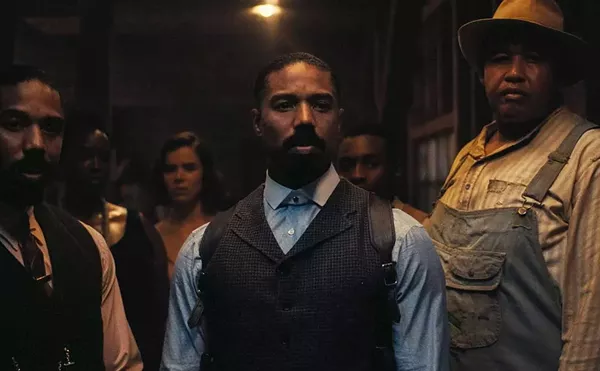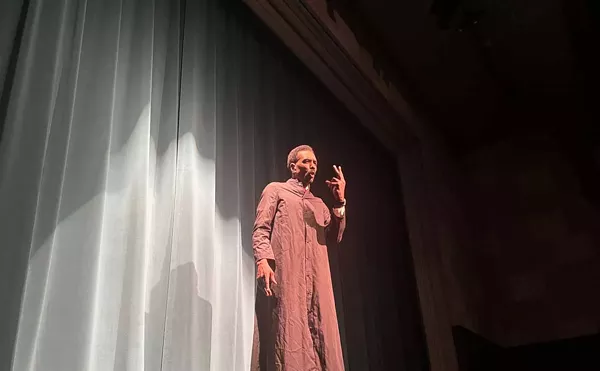
Audio By Carbonatix
[
{
"name": "GPT - Leaderboard - Inline - Content",
"component": "35519556",
"insertPoint": "5th",
"startingPoint": "3",
"requiredCountToDisplay": "3",
"maxInsertions": 100,
"adList": [
{
"adPreset": "LeaderboardInline"
}
]
}
]
Spend 40 minutes driving north on Woodward Avenue from Detroit's city center at Campus Martius Park and you'll find yourself in the vicinity of the Cranbrook Academy of Art, a revered graduate school surrounded by plush wooded plots and mansions in Bloomfield Hills. With flat land in every direction, the campus sits on a patch of rolling hills, between steep and narrow streets, with traces of European geography and architecture. It's a serene destination for serious art students the world over.
Before gaining admittance to Cranbrook last year, New Orleans native Kate Daughdrill, 25, focused her undergraduate work on printmaking as well as political and social thought at the University of Virginia. As if the vistas weren't enough, she was attracted to the school by what she describes as the community-oriented nature of its MFA program. "You work alongside and critique with the same 15 students in your department for the entire year. You even share a kitchen," she says. "I've always been drawn to cities, but I thought I would end up spending most of my time up at Cranbrook, on campus, because it offers such an intimate learning experience." She'd soon be proved wrong on that accord.
After visiting the school on her initial visit to Michigan, Daughdrill drove with a friend to downtown Detroit. They ate at a now-defunct Johnny Rocket's restaurant, a tacky, ill-attended chain once attached to the elegant Fox Theatre. "We were the only people in the restaurant," Daughdrill recalls. "I remember looking outside and noticing how few cars there were on the wide street. I remember driving away from Detroit thinking it seemed like a pretty empty and bleak place."
And for a lot of students and faculty at Cranbrook, it's hard to get beyond that first "bleak" impression. For one thing, students are far more focused on themselves and their fellows than the adjacent metropolis. "A graduate art program — especially one in such a secluded, enchanting setting — can be an all-encompassing experience," Daughdrill says. "There aren't many ways for Cranbrook students to naturally interact with the wider Detroit art community, especially when much of what's happening in the city functions in a more grassroots, underground way.
As for Daughdrill — who today will tell you that Detroit is a place she feels she was supposed to be living in for a long time — she says she didn't make a conscious effort to engrain herself in the city, rather she "just sort of fell in love with a group of people who live and make their work in Detroit."
That's how it happens sometimes. Detroit isn't easy. For better or worse, sometimes a stiff drink makes it easier.
Daughdrill was sitting on the bed of a pickup truck outside of a house party when Phreddy Wischusen, then general manager of the Crofoot music venue in Pontiac, strolled up and offered her a swig of whiskey. Within minutes the gregarious Wischusen invited her to an exploratory meeting to help a Crofoot exhibition celebrating local female artists. "I met a group of women who have since become some of my closest friends. None of us knew each other before that night, but by the end of it, we had shared some of our most personal stories and honest perspectives on what it's like to be a woman, specifically a woman artist living in Detroit," says Daughdrill.
Filmmaker Katie Barkel, photographer Vanessa Miller, multi-talented radio host Amanda LeClaire, Amy Kaherl, and musician Jessica Hernandez comprised the group.
After the first meeting, Hernandez — who had recently moved back to Detroit from Chicago — and Daughdrill sat at one of the bars at the Crofoot for a long while. Their conversation mainly revolved around their newly formed friendship — instant best friends as it were. Before ending the night on the dance floor they made plans for Daughdrill to create installations in a loft above the Mexicantown Bakery, owned and operated by Hernandez's family.
This collaboration evolved into Soup, a monthly dinner, mixer and source of micro-grants for creative projects.
Though Daughdrill creates art on her own, much of her artful work in Detroit, including Soup and the Beehive project — a meeting-place installation at the recent Movement electronic music festival — involve interactions in specially constructed spaces.
"We were interested in creating a gathering that would bring together diverse, creative people to get to know each other. We wanted to provoke accessible but critical dialogue about projects happening in the city and practically support each others' creative work," she says. A core group of about 30 people attend almost every Soup, including fellow collaborators who help organize the gathering, close friends, and community members who just dig it. Who the other 120 people showing up are depends on the night and the projects on the table.
Here's how Soup goes down: You arrive at 7 p.m. and by 8 or so, people have started taking seats at the low-set tables made from doors. Lit candles abound. A different person makes a pot of actual soup each time. Someone else makes a salad. Avalon International Breads provides, you guessed it, bread. The meal is vegan, of course. By a quarter to 9, those in the crowd vying for micro-grants take turns presenting their projects, then votes are cast in a private, makeshift voting booth. The winner is announced and the socializing — and networking — resume.
There are a wide range of proposals Daughdrill and Hernandez receive each month: All sorts of artists, farmers, builders and curators throw their names in the proverbial hat and leave with a couple hundred bucks.
"The diversity of the projects forces people to ask tough questions about what determines the quality of creative projects happening in the city right now," Daughdrill says, noting that the recent swell of press, including a mention on the front page of The New York Times, comes with as many positives as negatives. "My biggest fear with Soup is that it evolves into something unwelcoming, or attracts people interested in being spectators as opposed to participants," says Daughdrill. "Our biggest challenge is discerning how to grow and how not to grow."
A good portion of Soup's success is realized in its intimate setting.
"We are limiting the gathering to 150 people. If we end up having to turn people away, we hope we can make resources available that share our story, what happened at the Soup night they missed, and information about other granting dinners happening throughout the city." A group involved with the redevelopment of the Spaulding Court Apartments in north Corktown, for instance, just started holding a Soup night.
With projects such as Soup drawing local crowds and national attention, it's hard to contest Daughdrill's observation, even if she's not yet lived here a year, that something is happening in Detroit. If you're over 40, you've heard it before. But that's no reason to dismiss it. People are coming, however slowly, with good intentions.
"From the conversations I've had with folks who have lived here a long time, there's a consensus that Detroit does need more people, but it needs the right people. It does need to grow, but that needs to happen slowly and organically," says Daughdrill. "The people we need in Detroit are the ones who are excited to come alongside and support the good things already happening here, people eager to intertwine their lives with the artists, teachers, farmers and social organizations that are doing work here. We need the people who are ready to listen intently and really get to know their neighbors."
And right now, there are clearly plenty of like-minded folks ready to drink (soup) to that.
Travis R. Wright is arts and culture editor of Metro Times. Send comments to twright@metrotimes.com




